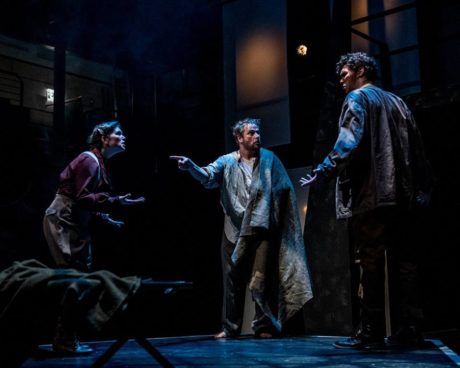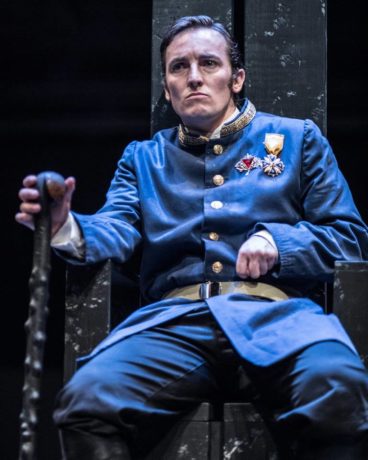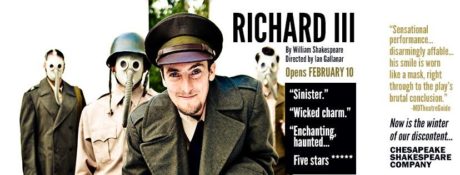It’s notable that a play based on England’s War of the Roses has many parallels to power plays that take place today, both in everyday life and TV and film. Chesapeake Shakespeare Company’s (CSC) Richard III, directed by that company’s Founding Artistic Director Ian Gallanar, is a perfect dramatic storm of great acting, dynamic visuals, and superior staging.
The play is influential to this day; it’s themes of overreaching power-lust are timeless. Historical tales such as this validate Southern novelist William Faulkner, who once wrote: “The past is never dead. It’s not even past.”; for the real Richard III’s bones were discovered at a parking lot construction site as recently as 2012.

In case your knowledge of England’s War of the Roses is fuzzy or non-existent, that history fuels Shakespeare’s fictional account (based on Sir Thomas More’s A History of King Richard the Thirde) of Richard, Duke of Gloucester aka Richard III who, starting in 1472, married his cousin Lady Anne Neville, the widow of the Lancastrian Prince Edward, and over the next dozen years murdered his brother George, Duke of Clarence, his nephews, child-princes Edward and Richard, and many others on the way to England’s crown. The goings on are far more Byzantine than can be done justice here, but it is notable that the similarly convoluted, popular HBO TV-series Game of Thrones is reportedly based on the War or the Roses as well.
In Richard III William Shakespeare created one of the most wickedly engaging anti-heroes in literature. Today’s popular culture anti-heroes from Tony Soprano to Walter White permeate the airwaves. Such characters can be traced back to Shakespeare’s fictional, hunchbacked Richard III, played with villainy and wicked charm by the spectacular Vince Eisenson, a member of CSC’s Resident Acting Company.
The rest of the cast brought a depth and special nuance to their individual performances. Lizzi Albert, as Lady Anne, particularly in her first scene with Eisenson’s Richard, who was trying to woo her at her husband’s funeral, was dynamite. Scott Alan Small, with his bowler hat, British upper-class suit, and gray goatee was awesome as Richard’s sycophant Buckingham, particularly when he sang Richard’s praises via microphone. Gregory Burgess, as Lord Stanley, gave an air of authority in all of his scenes. Mia Boydston as Edward, Prince of Wales, and Gareth Swing as Richard, Duke of York, played the two doomed nephews fantastically.
Ron Heneghan nearly committed stage larceny from Eisenson in his Tower of London prison cell scene as George, Duke of Clarence. His recounting of a horrific dream about a shipwreck rose and lowered to several emotional peaks and valleys. Dave Gamble was debonair and suave as Lord Hastings. James Jager as the Earl of Richmond (who prayed that he and his army would be “ministers of chastisement” to Richard) and Frank B. Moorman as King Edward IV gave regal, stately performances.

Eric Poch and Lee Conderacci played two of Richard’s assassins to good effect. Poch’s King Henry VI’s ghost scene was well done with smoky dry ice. The bald, sinister-looking Catesby was brought to life by few words but great body language by Joshua Witt.

Technical Director, Set, and Lighting Designer Daniel O’Brien built an impressive, three-story upstage-set on a three-quarter thrust stage. O’Brien made good use of behind-scrim light flashes, which simulated everything from camera light bulb flashes, assassinations and explosions.
Costume Designer Heather C. Jackson provided well-formed World War I British army uniforms. I was amused by the funky, steampunk sunglasses Jackson put on the assassin Sir James Tyrrell (Kelsey Painter). Sound Designer David Crandall helped create a martial atmosphere with use of off stage drums. Properties Designer Mollie Singer found several rifles from that era, and Fight Choreographer Christopher Niebling is to be commended for the physical combat scenes.
One unusual aspect of this production was that there were songs involved. I enjoyed the song “Pack Up Your Troubles in Your Old Kit Bag”. Vocalists included instrumentalist Scott D. Farquhar, Conderacci, Painter, Jager, Burgess, Lesley Malin (Queen Elizabeth), Kate Forton (Nun\Messenger), Bart Debicki (Sir Robert Brakenbury), and Patrick Miller (Sir James Blunt).
Chesapeake Shakespeare Company’s Richard III, with its superior production values, exceptional performances, and wonderful music, is a wintertime winner!
Running Time: Two hours and 30 minutes, with a 15-minute intermission.
Richard III plays through March 5, 2017, at Chesapeake Shakespeare Company – 7 South Calvert Street, Baltimore, MD. For tickets, call the box office at (410) 244-8570, or purchase them online.





